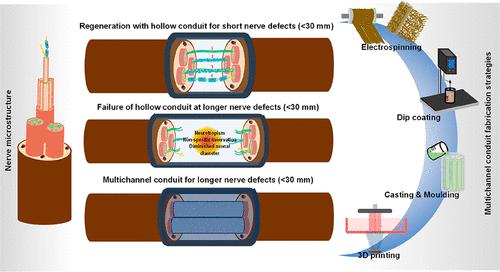当前位置:
X-MOL 学术
›
ACS Biomater. Sci. Eng.
›
论文详情
Our official English website, www.x-mol.net, welcomes your feedback! (Note: you will need to create a separate account there.)
Multichannel Conduits with Fascicular Complementation: Significance in Long Segmental Peripheral Nerve Injury
ACS Biomaterials Science & Engineering ( IF 5.8 ) Pub Date : 2024-03-15 , DOI: 10.1021/acsbiomaterials.3c01868 Preethy Amruthavarshini Ramesh 1 , Swaminathan Sethuraman 1 , Anuradha Subramanian 1
ACS Biomaterials Science & Engineering ( IF 5.8 ) Pub Date : 2024-03-15 , DOI: 10.1021/acsbiomaterials.3c01868 Preethy Amruthavarshini Ramesh 1 , Swaminathan Sethuraman 1 , Anuradha Subramanian 1
Affiliation

|
Despite the advances in tissue engineering approaches, reconstruction of long segmental peripheral nerve defects remains unsatisfactory. Although autologous grafts with proper fascicular complementation have shown meaningful functional recovery according to the Medical Research Council Classification (MRCC), the lack of donor nerve for such larger defect sizes (>30 mm) has been a serious clinical issue. Further clinical use of hollow nerve conduits is limited to bridging smaller segmental defects of denuded nerve ends (<30 mm). Recently, bioinspired multichannel nerve guidance conduits (NGCs) gained attention as autograft substitutes as they mimic the fascicular connective tissue microarchitecture in promoting aligned axonal outgrowth with desirable innervation for complete sensory and motor function restoration. This review outlines the hierarchical organization of nerve bundles and their significance in the sensory and motor functions of peripheral nerves. This review also emphasizes the major challenges in addressing the longer nerve defects with the role of fascicular arrangement in the multichannel nerve guidance conduits and the need for fascicular matching to accomplish complete functional restoration, especially in treating long segmental nerve defects. Further, currently available fabrication strategies in developing multichannel nerve conduits and their inconsistency in existing preclinical outcomes captured in this review would seed a new process in designing an ideal larger nerve conduit for peripheral nerve repair.
中文翻译:

具有束状互补作用的多通道导管:在长节段周围神经损伤中的意义
尽管组织工程方法取得了进步,但长节段周围神经缺损的重建仍然不能令人满意。尽管根据医学研究委员会分类 (MRCC),具有适当束状互补的自体移植物已显示出有意义的功能恢复,但对于如此大的缺损尺寸(> 30 mm),缺乏供体神经一直是一个严重的临床问题。空心神经导管的进一步临床应用仅限于桥接裸露神经末端的较小节段缺损(<30 mm)。最近,仿生多通道神经引导导管(NGC)作为自体移植替代品引起了人们的关注,因为它们模仿束状结缔组织微结构,促进对齐的轴突生长,并具有理想的神经支配,以实现感觉和运动功能的完全恢复。这篇综述概述了神经束的分层组织及其在周围神经感觉和运动功能中的重要性。本综述还强调了解决较长神经缺损的主要挑战,以及多通道神经引导导管中束状排列的作用,以及束状匹配以完成完整功能恢复的需要,特别是在治疗长节段神经缺损时。此外,目前开发多通道神经导管的可用制造策略及其与本次综述中捕获的现有临床前结果的不一致将为设计用于周围神经修复的理想更大神经导管的新过程带来种子。
更新日期:2024-03-15
中文翻译:

具有束状互补作用的多通道导管:在长节段周围神经损伤中的意义
尽管组织工程方法取得了进步,但长节段周围神经缺损的重建仍然不能令人满意。尽管根据医学研究委员会分类 (MRCC),具有适当束状互补的自体移植物已显示出有意义的功能恢复,但对于如此大的缺损尺寸(> 30 mm),缺乏供体神经一直是一个严重的临床问题。空心神经导管的进一步临床应用仅限于桥接裸露神经末端的较小节段缺损(<30 mm)。最近,仿生多通道神经引导导管(NGC)作为自体移植替代品引起了人们的关注,因为它们模仿束状结缔组织微结构,促进对齐的轴突生长,并具有理想的神经支配,以实现感觉和运动功能的完全恢复。这篇综述概述了神经束的分层组织及其在周围神经感觉和运动功能中的重要性。本综述还强调了解决较长神经缺损的主要挑战,以及多通道神经引导导管中束状排列的作用,以及束状匹配以完成完整功能恢复的需要,特别是在治疗长节段神经缺损时。此外,目前开发多通道神经导管的可用制造策略及其与本次综述中捕获的现有临床前结果的不一致将为设计用于周围神经修复的理想更大神经导管的新过程带来种子。



























 京公网安备 11010802027423号
京公网安备 11010802027423号